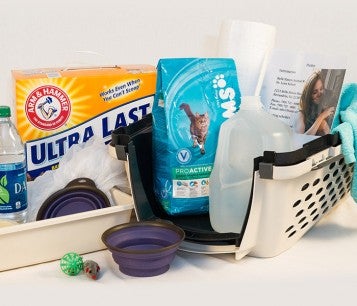I often tell stories of how our incredibly dedicated disaster response team deploys to help animals in the aftermath of devastating storms. But our teams work all year round to ensure that communities have plans in place to keep all residents safe, including the animal members of our communities. Here, Celia Jackson, program manager of disaster response for the Humane Society of the United States, gives an overview of what the team has been doing to help people prepare and how you can best equip your family for emergency situations that may affect your companion animals.
Earlier this week, Hurricane Beryl intensified as a Category 4 storm, continuing a storm season that’s already been called unprecedented. When hurricane season officially started June 1, hundreds of severe weather events had already swept across so many communities during the spring, causing widespread damage. In May, a derecho (a straight-line wind event with wind speeds like a tornado) unexpectedly hit the Houston area, and tornadoes touched down across the South. And since storm season started, dangerous heat waves have occurred around the country. Tornado watches were even issued for New England. The first named storm, Tropical Storm Alberto, bore down on Mexico in mid-June. Wildfires in California and New Mexico have sent communities scrambling. People throughout the U.S. are facing many hazards. And what people face, so do animals.
This underscores the importance of disaster preparedness. Our Animal Rescue Team’s disaster work goes beyond the boots-on-the-ground response in the aftermath. Our team works with communities across the U.S. all year round to help them prepare for storm seasons that have become increasingly severe. For example, last November, we helped the Virginia Federation of Humane Societies plan and prepare for keeping animals in shelters safe through storms. Our disaster team also regularly conducts virtual preparedness trainings. We also presented on planning for animals in disaster at Animal Care Expo in San Antonio in May. Often, communities were unprepared for the devastating storms that hit them in the past and wanted to increase their readiness moving forward.
And after storms hit, we rush to provide communities with the supplies they need to take care of their animals. After the Texas derecho in May, we provided 400 extra-large wire crates to Houston Humane Society to distribute to people who needed a way to keep their animals safe and secure despite the damage to their homes and yards. In addition, pet food retailer Chewy donated a truckload of supplies that our Pets for Life program provided to Houston Humane to support underserved communities in the region. In Kentucky, Muhlenberg County Humane Society’s roof was damaged in a tornado; we are funding the repairs so that the facility can once again do its crucial work of housing homeless animals.
For animals who do have homes, it is essential to make sure they do not get lost during extreme weather events. The work of reuniting animals with their families is intensive for already busy shelter staffers, and shelter space to temporarily house lost pets in the aftermath of a storm can be hard to find. And of course, these situations have an emotional component. When people lose their homes or belongings in a storm, it is immensely comforting for pets to stay with families; it maintains the human-animal bond and allows both people and animals to recover from adversity and feel strong and resilient.
As we look toward another busy hurricane season, we’re reminded how important it is to be prepared.



